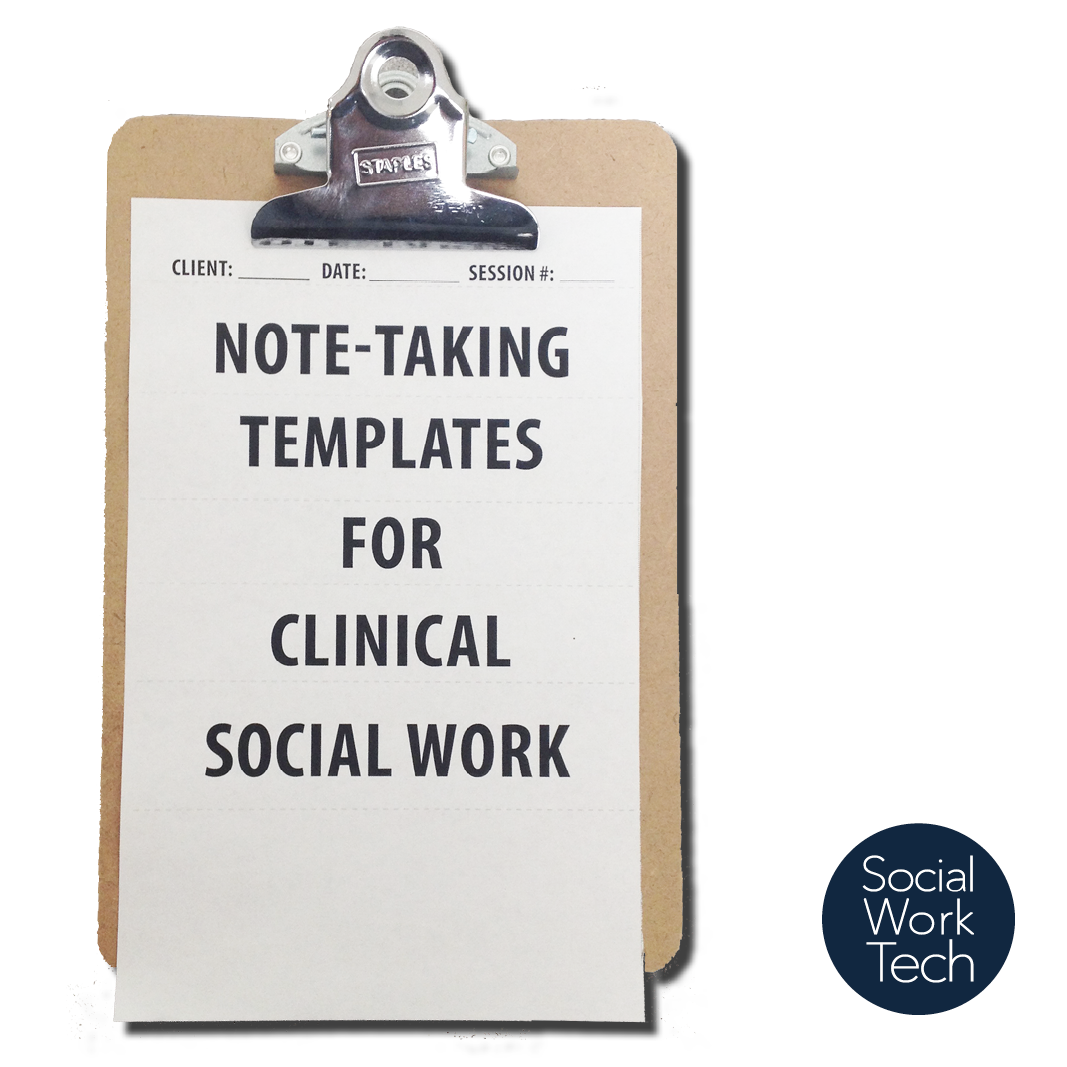I wanted to share with you something that I have made for myself to use for my clinical practice. It is intended to help me with my documentation via note-taking. I would like to take the opportunity to remind you that the information that follows is for entertainment purposes only and is not considered clinical advice for how to practice social work with your clients.
Pen and Paper… OMG?
OMG is right! I have been a happy iPad user for four years and nothing beats pen and paper for taking notes when you are sitting with a client. Nothing. Also, paper can be shredded and destroyed.  In my personal productivity, paper is the best when taking notes in an administrative meeting or clinical setting. Studies show that handwriting notes can be more effective than typing your notes. I use my Moleskine to make notes, draw out concepts, mind map, or hash out pieces that I can put together later.
In my personal productivity, paper is the best when taking notes in an administrative meeting or clinical setting. Studies show that handwriting notes can be more effective than typing your notes. I use my Moleskine to make notes, draw out concepts, mind map, or hash out pieces that I can put together later.
A lot of people are writing notes everywhere they are and with whatever is handy so that means on a computer or other digital device or on paper. Paper is still better for a lot of things. Here are just a few of the many reasons paper is still around
From “Writing on the Go: Where Paper and Pen Fit Now” by Janet Tokerud
Janet writes about her love of paper and I agree with everything she has to say. 
The Need for Templates
These clinical templates are a project I have taken time to make because it makes my work flow easier… I am given a direction for the notes I should be taking, in case I somehow forget to ask about an important aspect of my interview, e.g. assess for a support system. It helps for documentation purposes and they get shredded immediately after I type up my clinical case note.
Template Example
Below is a template that I created for use for crisis sessions.  This template is an example of a crisis note that I have made
This template is an example of a crisis note that I have made
Process
A few steps for the brave that want to venture into a similar template for themselves.
- Determine what type of template I need, e.g. assessment, regular case note, crisis note, etc.
- Determine what type of information I absolutely need to collect in my session.
- Lay out the different sections on my template in a manner that makes sense. For example, I will want a larger space to take notes on the interventions that I have done, as compared to documenting the goal of the session.
- After choosing a font, I modify the text so it is large and transparent (I tell InDesign to make it 40% transparent so I can write over these prompts).
- Shrink the template so that two can fit on one 8.5 by 11 inch piece of paper when I print it. If you make a full template on Microsoft Word, you can do this by copying the template you have made, adding a second page (via Page Break) and adjust your Print settings so that your printer prints two pages at a time in Landscape mode.
While I used Adobe Indesign to make this my templates, a similar process can be done via Microsoft Word using Tables. If you are interested in using the Adobe Suite, check with your University to see if you can purchase it inexpensively or use the software in a computer lab. I use Adobe’s Classroom in a Book series to help me learn how to use the software.
Example of Use in Practice
Below is an example of a template I have used for my “client”, A.L.T. who came in for her third session with me. While this looks like a lot of writing, I am engaged with my client. I write the presenting problem and it helps to provide a direction to best serve the client.  I use short-hand case note writing to jot down what I will ultimately be documenting in my case note and this scrap paper is immediately shredded.
I use short-hand case note writing to jot down what I will ultimately be documenting in my case note and this scrap paper is immediately shredded.
Sample For Your Own Practice
The above template is available for you to sample to see how I use it. It is not intended as clinical advice nor does it supersede your own way of practicing clinical social work.
- PDF Download: Sample Case Note Template
- PDF Download: Sample Brief Assessment Template









This is brilliant. I created something similar in the 1990s, but I like yours much better. Thanks for sharing your genius with the world!
What does the assessment template look like? This is a great idea and will help when I’m seeing a number of clients during the day and during supervision.
I updated this post with the requested document! Please remember that this is for reference/entertainment purposes.
Hi Ignacio
I’ve spend most of today trawling the internet for a sample of how and in what format therapists jot down their notes and I came across your blog – thank you so much for shedding light on the this subject!
I have been taught, not only through grad school but through extensive trainings post-Grad school, that it is inappropriate to take notes during a session with clients. An exception to this is an intake. During a one-on-one therapy session, the clinician should be focused in on what the client is saying, not looking down at paper taking notes. It can be seen as rude and insensitive, as studies have shown a common response from a client while a clinician is taking notes is “oh my gosh wait is she writing about me?? I bet it’s bad.”
[What follows is not legal or ethical advice in the practice of clinical social worker, psychotherapy, or related disciplines.]
That’s all well and good that you got that from your trainings and I am assuming that this is for strictly psychotherapy interactions? I do psychotherapy in tandem with case management (i.e. clinical) social work.
As far as the NASW Code of Ethics (2008), I don’t see your concerns violating the following relevant Values:
Dignity and Worth of a Person: “Social workers treat each person in a caring and respectful fashion…” If my judgement is that note-taking is interfering with my client’s dignity, of course I would not.
Importance of Human Relationships: “Social workers engage people as partners in the helping process.”
Integrity: “Social workers behave in a trustworthy manner.” I’m counting on the relationship with the client, as well as other factors, to help me have credibility with my client.
Section 3.04 discusses client records, specifically, that “(a) social workers should take reasonable steps to ensure that documentation in records is accurate and reflects the services provided”.
I have found that when clients react to the gesture of writing things down, they tend to be appreciative that I can use the analytical part of my brain, in tandem with the emotional and creative side, to help them get what they need out of me in the 50 minutes they have with me. Of course, what I write down gets documented and the scrap paper is sent right into the shredder immediately.
I’m just curious as to how you recall everything in an incredibly convoluted session you may have with a high-risk client that involves legal and ethical considerations, as well as the potential around consequences around safety?
Also, literature would be appreciated and help me see your side of the debate.
Thanks for stopping by!
Although it is very important to listen and pay attention, I find that my clients do NOT mind when I am writing. I tell them that I like to make notes, and that the notes generally are verbatim reports of what they’ve said, and that they are free to access these notes at any time.
I do not keep my eyes on the paper but may glance at it occasionally. Needless to say, the writing may not be excellent, but at least I have captured my initial impressions, and do not have to entirely reconstruct the session later from memory.
Jane
LOVE this!!
Does anyone have information about how updates in technology fit into SW practice? Any pertinent articles? Thanks:)
Working at a school where everyone is trying to use computers for everything.
Love how you handled this Ignacio! Swoosh!
Much appreciated! Many thanks!